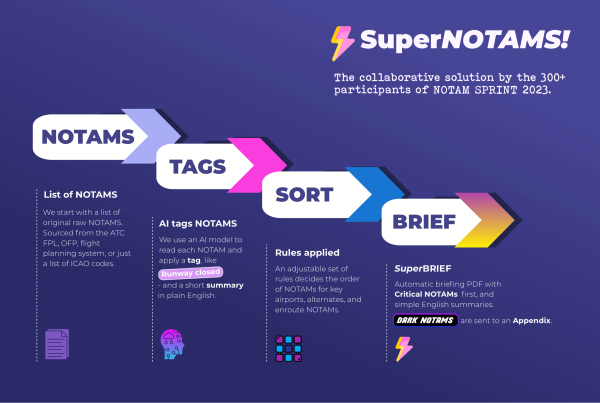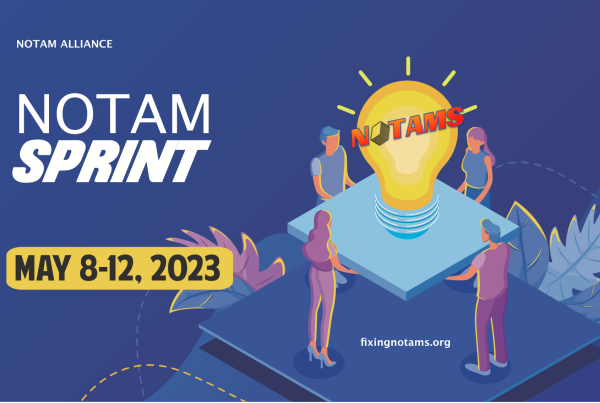The Monday morning Washington weather started out grey, overcast, looming.
A little chilly. Chance of rain.
A consummate match for the cloud of despair that we pilots and dispatchers know NOTAMs to be. The weather gods were paying attention. Were the people that matter?
The story has been told, the stage is set. We’re here for a Notam Summit. We’re here to get something done.
The NOTAM problem is clear. We have an antiquated, cumbersome, ineffective, frustrating, dangerous system. Pilots are missing the essential few pieces of information, unable to hear the call of criticality in a cacophony of irrelevant noise.
2019 has been the Year of Fixing Notams.
Never before have we had this energy. Not in 1964, when we were first promised a better system, not in 2014, when the MH17 crew were cruelly handed a set of unusable coordinates and cryptic text to warn them of the risk in eastern Ukraine, not in 2017 when I wrote that Notam article, nor a few months later when the Air Canada crew became victim to the same problem. Nor in 2018, when we ran the Notam Goat Show in Geneva, and first published our Field Guide to Notams.
No – this year is different. This year, enough people agreed, talked about the issue, and wanted to make it change. The energy was flowing. It came from Robert Sumwalt’s brave and direct comments (when the NTSB says Notams are Garbage, people listen). It came from Heidi Williams’ AIS Reform team. It came from ICAO. It came from OPSGROUP’s 6000 members. It came from the Notam Team. And maybe, the echoes of that BS Notams blog post were still being heard. Overton’s window was finally open – discourse was going to happen. And so, all roads led to Washington.
A Summit is different to a conference. In a conference, we are generally imprisoned in uncomfortable rows of waiting-room seats, faintly hoping beyond hope that the Death by Powerpoint speaker might only over-run their allocated time slot by a half-hour, and when released, manoeuvre ourselves to the coffee station in our ill-fitting ‘business-casual’ garb to find some mutually agreeable idle chit-chat to bring the end of a dull day closer.
In a Summit, there’s a clear attachment to an outcome – getting something done. Its dictionary definition says it’s a top-level meeting of minds, and those minds were here. So, the name was very promising. Would it deliver? Would we deliver?
Outside, Independence Avenue was still grey.
The presentations came thick and fast. We watched, we listened. A steady stream of people showcasing how they manage the problem – how they are parsing the current format of Notams. Flight Briefings from Leido. Fancy graphics from Foreflight. DoD flight planning interfaces. Notam Search from the FAA. A multitude of front-ends that attach to a gremlin-laden back end with all the structure of a chronic hoarders hallway.
And now, an outsider: Drew Zachary from the US Census Bureau. But wait, can aviation learn from not-aviation? Surely we have all the answers here already? What could we learn from someone outside our field? As it turned out, everything. Of all the morning presentations, this one would set the scene for a change in the weather. Turns out, it’s not an aviation problem, it’s a data problem. And Drew showed us some novel things: How to build an API. How to listen to customers. How to structure large chunks of source data. How to make data available in a form that allows the customer to use it effectively.
Wow.
But dreams were quickly crushed. We were told by the next speaker that building fancy API’s were for the Stripes and Slacks of this world, and not for the FAA. Granted, Stripe (payments) and Slack (messaging) have a combined valuation of $48 billion and lead the way for API design and documentation, so they have the resources, and in fact, you could argue that Stripe is an API rather than just having one. But, I had a feeling that the point was being missed.
And so, lunch. A few things to mull over, some time to ponder and wonder. So far, nothing ground breaking. It wasn’t a conference, but it wasn’t a Summit, yet.
Across the street, in the Smithsonian, the annals of our aviation history are stored. The Spirit of St. Louis rests alongside the Concorde and the Discovery, their stories complete, and told. I wonder whether they feel something stirring here. I wonder if the weather might change.
Enter Abby Smith, FAA.
Just behind those aircraft-at-peace lies the White House, where Ronald Reagan famously said, “The nine most terrifying words in the English language are: I’m from the Government, and I’m here to help.”
There’s a strong urge in our ops community to lay the responsibility for the Notam problem at the door of Government. After all, in each country around the world, it’s the CAA, CASA, the DGCA, the FAA – the agency, the administration, the authority, the directorate: all of which are the Government, that is responsible for the steady stream of Notams. Can they truly take responsibility for fixing them, too? Or do they just want to look like they are?
I like to believe there are no coincidences. After lunch, the sun comes out. That ominous, nebulous overcast is steadily replaced with warming rays of November sunshine. Abby is that light. She is, unquestionably, truly here to help.
Abby Smith’s title is FAA Executive Champion of NOTAM Modernization. Back to the dictionary. “Key agent of change … the Executive Champion must gather resources, create a strategy, and keep the process moving. They must manage points of contention and chart the course to full acceptance.”
The title is telling, and shows that the vision is real. The FAA really wants to see Notams fixed. And nobody in the room here is more engaged, enthusiastic, and empowering than Abby.
Abby has decided that we need to move from presentation to discussion. There are enough Notam users here, enough data experts, enough people with the pain of the problem, to get something done. Groups are formed around topics. People get down to the nitty gritty. Conversation, discussion, ideas. Questions are asked. Answers start coming.
Things are looking up. In the group conversations, some clear lines of thought start to emerge. The sun is shining.
So, what was said?
Back End vs Front End
The symptoms of the Notam Problem are many. The problem however, becomes clear and singular: the data is unreliable.
We tend to spend a lot of time looking at the Front End of the problem – the app (like Foreflight), the web page (like Notam Search), the printed briefing (the 50 pages of junk). Lots could be done to make those prettier, easier to read, and attempt to sort for some kind of criticality, or by date. OPSGROUP and ICAO even built an AI bot called NORM. NORM is true AI: Deep Learning using NLP. In other words, a machine trying to understand human language. It took 2 million Notams for NORM to begin to understand what the message of one was – and that shows the problem.
But the front-end innovations can only be a plaster on the wound, and never a solution that truly solves the problem.
The problem lies on the Back End. That is, the underlying data that is used to power all of these Notam processing and briefing tools. Even with all countries adopting the ICAO standards for Notam format (Canada just got there, the US will in 2020), it doesn’t change much. The data remains unreliable – especially from a machine perspective.
Let’s leave the Back End issue there for a moment, and skip to what the solution might look like.
The Solution
Let’s look at another source of worldwide information – the Internet. It’s nothing more than a collection of information. How do we find what we want?
Well, mostly we go to Google, and ask it something, like movie showtimes near me. We get some results, and can pretty quickly figure out that the 7pm showing of The Irishman at AMC is the one that works for us. Done.
What Google is doing is applying a set of rules to fish out the relevant stuff from a sea of information. The algorithms are complex, but the principles are simple – a keyword search, with a set of results sorted in order of relevance. The more keywords, the better the search results. What we don’t expect from Google – nor could we ever humanly process it – is a listing of all the results for for that search in no particular order. We don’t trawl through all 5,000 or so movies showing, and all 500 or so cinemas in New York, and review every match.
Google is the Front End. And the back end – in this case web pages, document, images – is structured in a way that makes Google work well. It only works because web pages are all structured the same: page titles, headings, sub headings, words in human language, document endings, usable head and body tags, HTTP headers, and so on.
A Notam Briefing could do the same effectively, if the Back End data was structured in a useful format. Again, to Google. We don’t ever complain there are too many web pages on the internet.
With good data, we’d have the ability to set different Profiles, and query relevant Notams for our route of flight. There would be no limit to the number of profiles, but we could set basic types – maybe ‘Airline, International’, ‘General Aviation, Domestic’, ‘Helicopter, local’, ‘Business Jet Trans-Atlantic’.
Now with our base Profile, we can set more rules, so that our pilots and dispatchers end up with a curated, clear list of relevant information in order of criticality. High risk situations first. Airport closures, runway closures. ILS outages. Color them red, color them pink – whatever – the Front End can decide that.
And because we are querying for useful Notams, not just seeing them all, it means that the legal argument is also solved. You know, the usual answer when we ask why Sydney is publishing lists of Gum trees, why Birds of Bangkok, why Grass Cutting times in Waterford, why Red Foxes in Teterboro, why 17 million Unlit Tower Notams across the US, why every Crane of Innsbruck gets its own Notam (complete with full address so you can visit it) – the answer: the lawyers say we have to.
It would no longer matter. Welcome them all! Let Greece and Turkey continue with their War and Peace territorial disputes echoed in the Notam System (10 pages of them in most Mediterranean pilot briefings). It doesn’t matter. They won’t end up in the Briefing, because we’re now querying for relevant Notams, and we can finally dump the garbage. And the lawyers can sip easily on their 5pm gins knowing that everything that could be put in, has been.
Creating useable data structures
Let’s remember for a moment that this Summit was addressing the US Notam System. That said, and as Alex Pufahl at ICAO brought attention to in the closing remarks, if we fix this 1 country – there are 192 others with Pilots and Dispatchers waiting for a solution.
But the energy here in Washington is stronger than anywhere else. In this room are the people that can make Notams better, and a fix for the US, is potentially a fix for the world.
The key point is data. Structured, reliable data – getting technical: maybe JSON, maybe AIXM – available through an API. That much seemed to be agreed. Even if Stripe and Slack are streets ahead in the ability, the fact remains that the FAA needs to build an API so that customers of Notams have a single point of access to integrate the data into their systems – whether that customer is an ATC Center, an airline ops room, a planning tool, a Flight Plan provider, or a lone pilot.
Last year, Robert Sumwalt also said that Notams are “written in some kind of language only a computer programmer would understand”. He’s right. And, that’s the issue: we’re looking at the data stream. We shouldn’t need to. The only reason we’re seeing the data stream, is that the system is broken, and we have no choice.
The Snowstorm.
Something shifted in Washington on Monday. And not just a little. So much was explored, talked about, discussed, and so much moved forward, that Alex told me it was like a Notam Snowstorm – too much to process and digest right away: you have to wait for the snow to settle, and the sunrise the morning after, to see where things are, where the snow has settled on the ground. A perfect analogy, I think.
Well, the snow is settling. And the Notam landscape looks different. The task remains onerous, but I believe true change is now possible, and that’s not a light position to take after 55 years of none.
The participants were asked when how often we should reconvene for a Notam Summit. The popular answer was every 6 months, and it seems that July next year is likely for the next round.
So, we got something done. The FAA is not only listening, but actively creating change. Let’s keep the energy going.
And that’s why an API is not just for Slack and Stripe. We need a Notam API – one that talks to a data set with a reliable, dependable, clear, useful structure.
Bye bye birds of Bangkok. Fingers crossed.
A report from Mark Zee, at the FAA Notam Summit – November 18th, 2019, Washington.









Thanks Mark for the update and summary of the event…as you say, it is good to keep the momentum going and the ppl interested to actually change…Tech Tools – we have and often is the best solution simple, but simple does not mean easy. I always ask ppl, who promised our task would be easy? it is all a matter of perspective.
cheers from wintery Zurich, iris